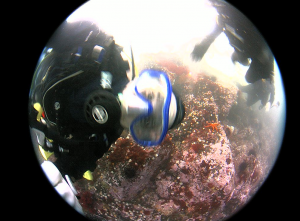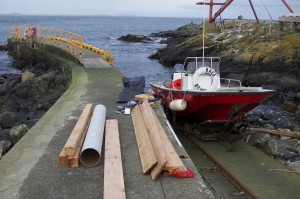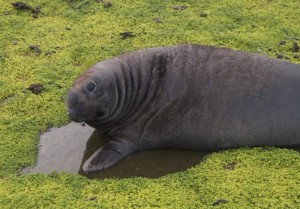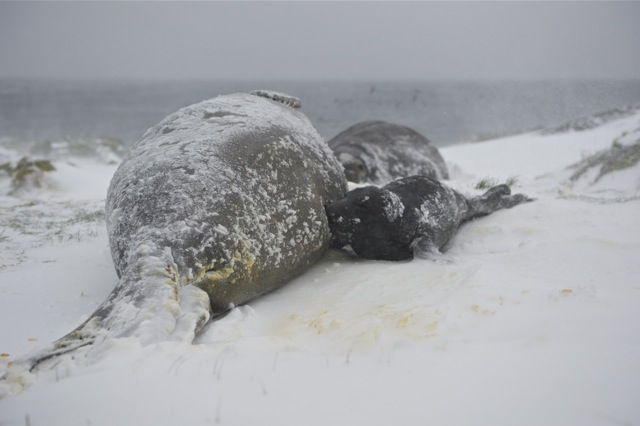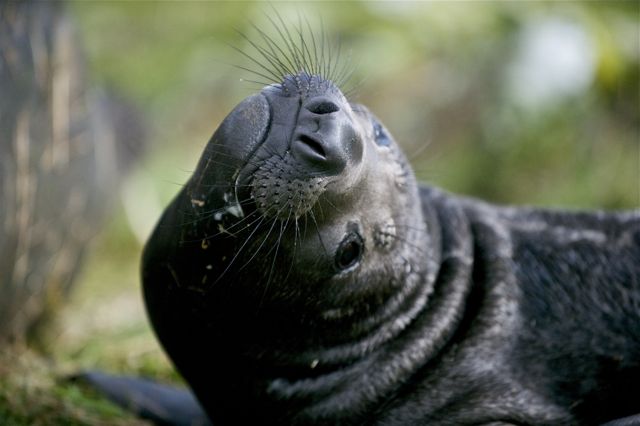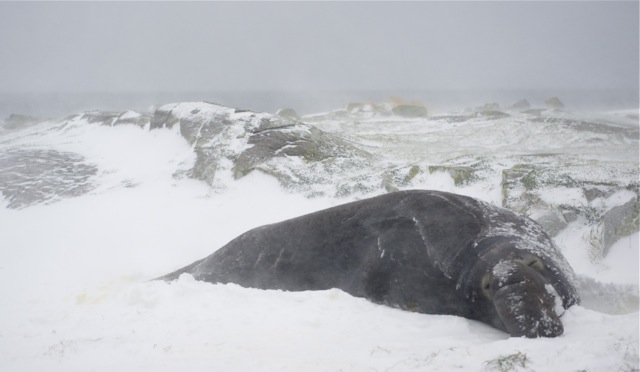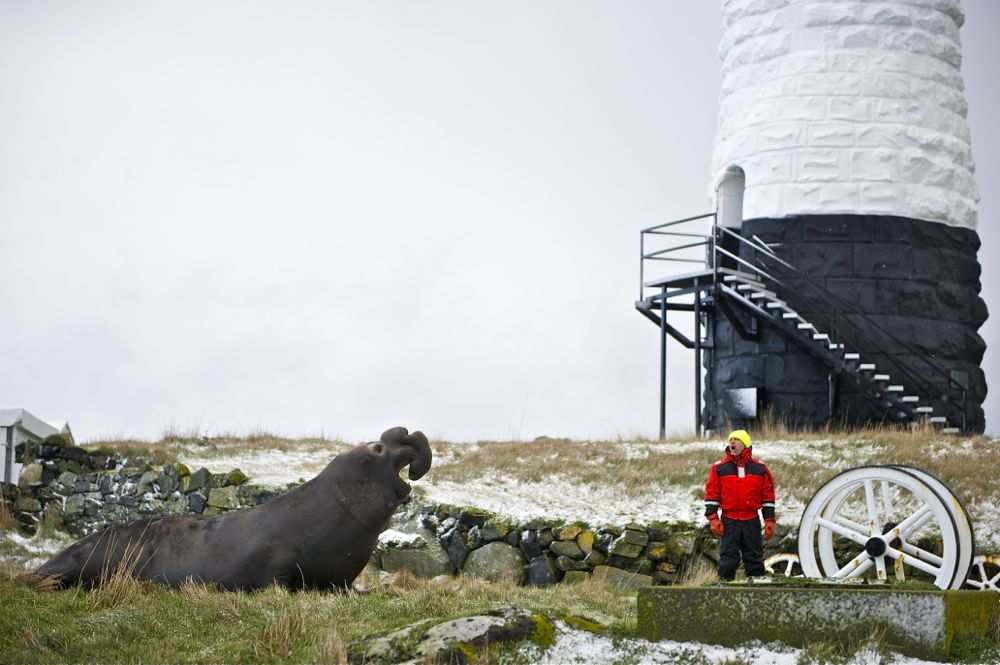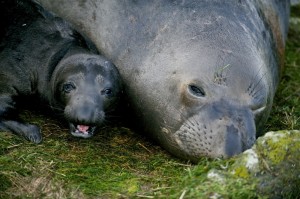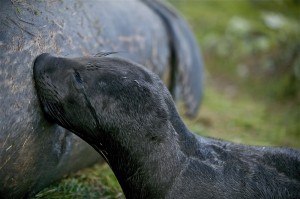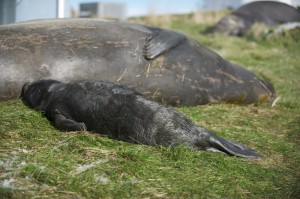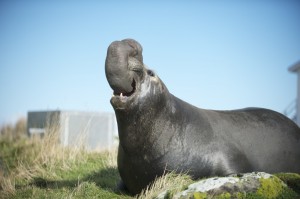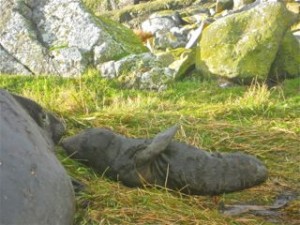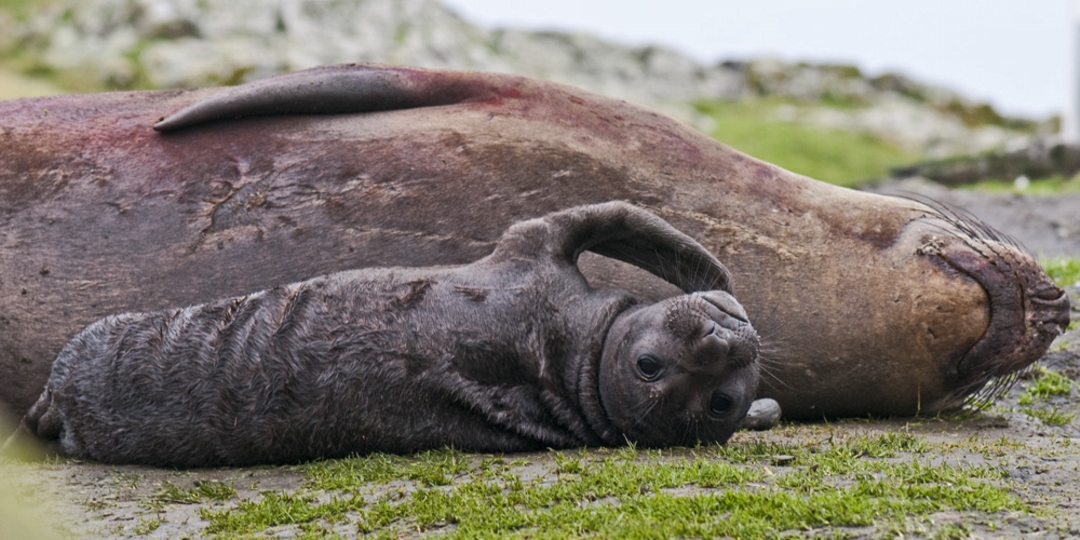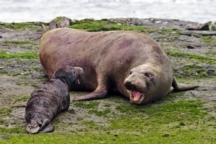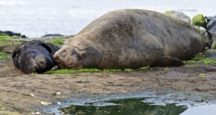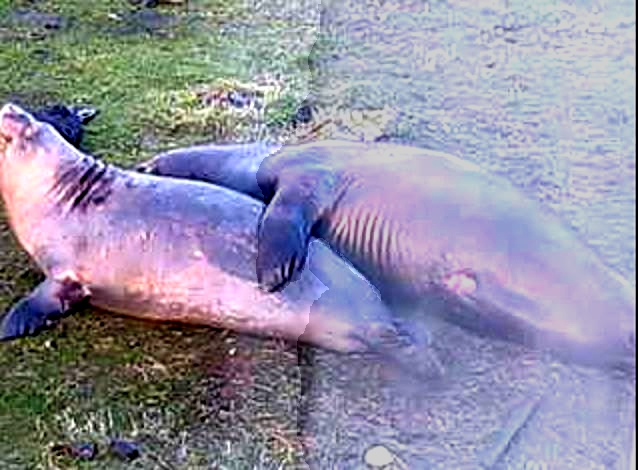0758 hrs February 7, 2010: Today a new elephant seal pup was born on Great Race Rock . Follow the story below as we track what happens to this new pup. Photos by Ryan Murphy
Also see the excellent photos and video by Raisa Mirza of the pup in 2010
Feb. 7, 2001: “The newest addition at Race Rocks: Sometime last night the second elephant seal to be born on Great Race Island arrived just a couple metres from the Science Centre. Faculty member Garth Irwin who was staying there, was the first to spot it this morning.
‘Elephant Seal’, 7, ‘I received a phone call this morning from the Chemistry teacher at Pearson College who was here overnight. He and his mother had heard “Bertha ” in the night and woke to see a new elephant seal pup and a group of eagles tearing at the afterbirth. Both Camera 1 and 3 are now located in the S window of the Science Centre, right above the action. The pup appears to be a male, and this time is the offspring of our other resident male “Misery” not “Slash”.’, ‘Ryan’, ’13:13:04 ,
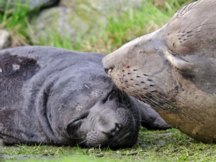 This pup appears to be a boy; the mother is Bertha (Ninene’s mother) and father is perhaps Misery (the younger of our two resident males). This would be Misery’s first offspring. |
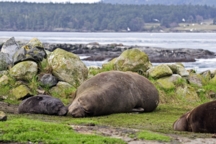 “In this picture you can see Slash and his harem in the background. Slash (our oldest resident male) is hauled out on Middle Rocks with 3 females. There have been at least two births out there this year, but the high tides and storm surges washed away the first and most likely the second as well. . |
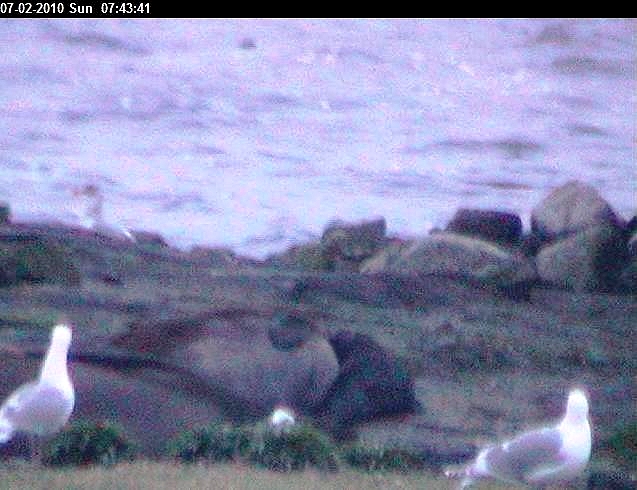 A minute after Ryan sent in his report of a new pup, at 7:59 AM, Pam from England reported it on Camera 5. She had taken the photo just at dawn at 7:43.. |
Pam went on to say “Saw the eagle eating near Bertha and Misery ..guessed it was a placenta…..new pup seen when it became light…lying by Bertha’s head.”Pam goes on to say “I think the pup had only just been born. It certainly wasn’t there last night when I was watching Bertha. At that time she looked uncomfortable and kept shifting about. Misery incidentally has hardly lifted a flipper during all this excitement.” PB.
|
|
|
|
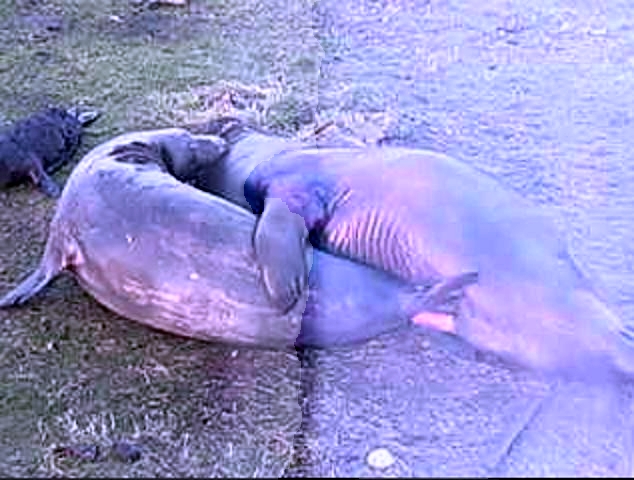 |
| February 8, Bertha and the pup are doing well. Photo by Ryan Murphy. |
Mother and pup sleep on the lawn south of the science centre. Photo by Ryan Murphy |
Photos from camera 1 by Pam Birley ..see next few lines: |
Misery mating with Bertha, photos by Pam Birley from Camera1 |
On Feb.13, Ryan reported in the Daily Log: ” Misery was observed mating with Bertha today around 1500hrs. Much less of a production than last year and the baby is keeping out of harm’s way.”
On camera 1 ( above two images) : Early morning Feb. 17 Pam Birley reports: “The family seem to have settled down very well and Bertha is allowing Misery to mate with her quite often. Misery seems very contented therefore right now and does not seem to be harming the pup in any way. The pup just keeps out of the way when they are mating and then goes back to feeding afterwards.
However the optimism was only for a few days.
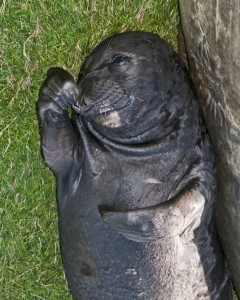 Ollie when life was good! |
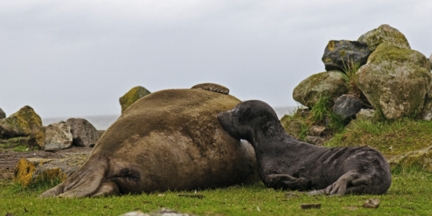 For the first two weeks the pup had done well, nursing almost constantly and gaining weight in preparation for weaning at 5 or 6 weeks.. and then. tragedy strikes.. |
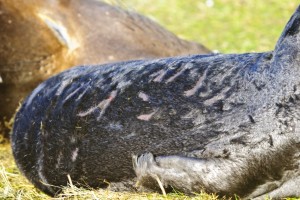 By February 17.Ryan sent this image: “The pup has 20 or so long scratches across its back this morning. I heard a lot of noise last night and was able to see Misery go after the pup numerous times. It seems that this bad behaviour only happens at night, and the pup is quite chubby and active compared to poor Ninene last year. Still another 6 weeks to go, and who knows what Misery will do once Bertha leaves. I had noticed cuts on the pup’s chin a couple days ago, but its perfect baby coat is now marred. Ryan reported in the daily log of February 17:” Last night was a rough night for our newest pup as Misery was trying to mate with it. Tooth marks on the pups chin were evident a couple days ago, but now its baby coat is marred by 20cm scratches from Misery’s sexual aggression.”
By February 17.Ryan sent this image: “The pup has 20 or so long scratches across its back this morning. I heard a lot of noise last night and was able to see Misery go after the pup numerous times. It seems that this bad behaviour only happens at night, and the pup is quite chubby and active compared to poor Ninene last year. Still another 6 weeks to go, and who knows what Misery will do once Bertha leaves. I had noticed cuts on the pup’s chin a couple days ago, but its perfect baby coat is now marred. Ryan reported in the daily log of February 17:” Last night was a rough night for our newest pup as Misery was trying to mate with it. Tooth marks on the pups chin were evident a couple days ago, but now its baby coat is marred by 20cm scratches from Misery’s sexual aggression.”
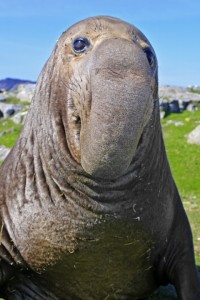
- No doubt the accused and the guilty one.
In this second week Ollie too had become the object of aggression by Misery. Eventually, after three weeks, Ollie was dead and the bite marks on the back and the loud cries heard at night suggested that Misery was to blame.
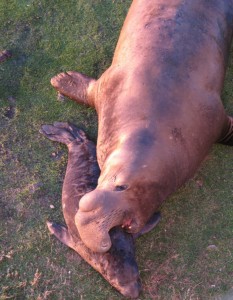
- Assistant guardian Murray took this photo from the window of the science centre from above. It shows Misery and the dead pup.
| And then in what seemed to be a repeat of last year’s behaviour patterns. In the March 2nd daily log Ryan notes that Slash was on Great Race Island, mating with Bertha and Misery had had a fight with the old male. The following pictures show the end result with the injuries sustained by Misery.(Perhaps to anthropomorphize…you might say justice is served?)
In 2011, another pup was born to Bertha. Given the past record with Misery, the outcome was inevitable. The pup lived only a week or so and then was crushed by Misery |
-
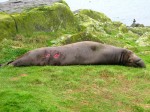
-
March 1, 2010: Misery after the fight with Slash Murray Sager Photo
-
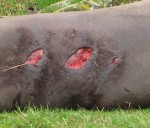
-
March 1 Misery after the fight with Slash.
-
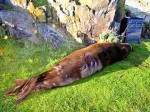
-
March 3, Misery with cuts
-
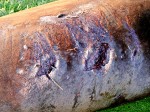
-
March 3 cuts close up (Ryan Murphy photos.)
The Elephant Seal taxonomy and Index.
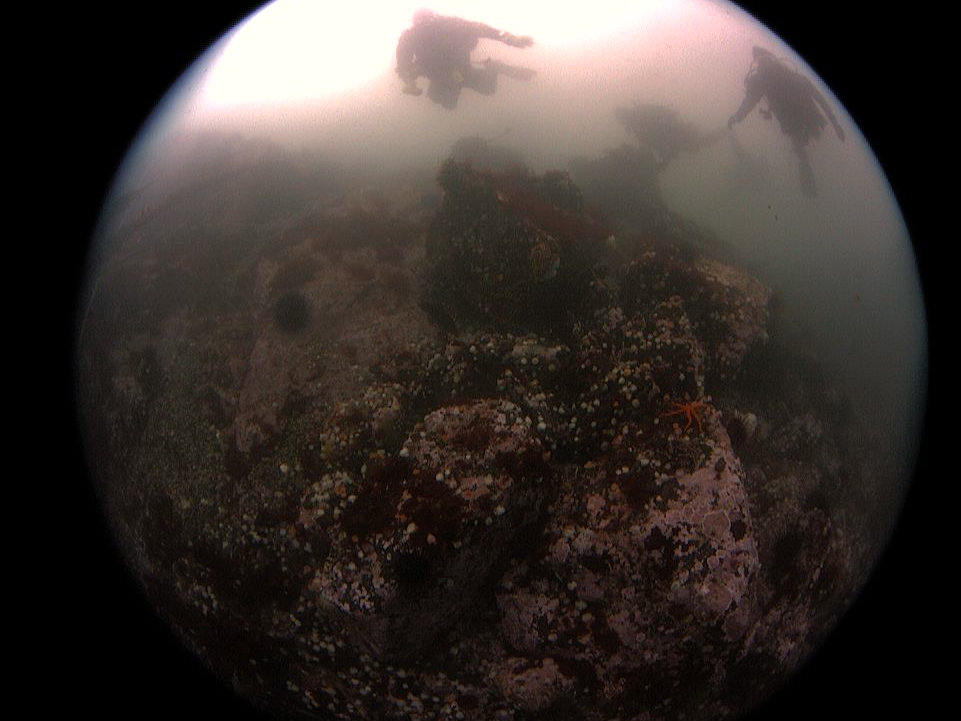 On Wednesday afternoon the elephant seal with double green tags 5086/4665 hauled out again on the boat ramp and has remained around the jetty for the past days. Today I noticed another elephant seal in the South bay with green tag # 6355. This appears to be the same one that Mike reported in early January.
On Wednesday afternoon the elephant seal with double green tags 5086/4665 hauled out again on the boat ramp and has remained around the jetty for the past days. Today I noticed another elephant seal in the South bay with green tag # 6355. This appears to be the same one that Mike reported in early January. 